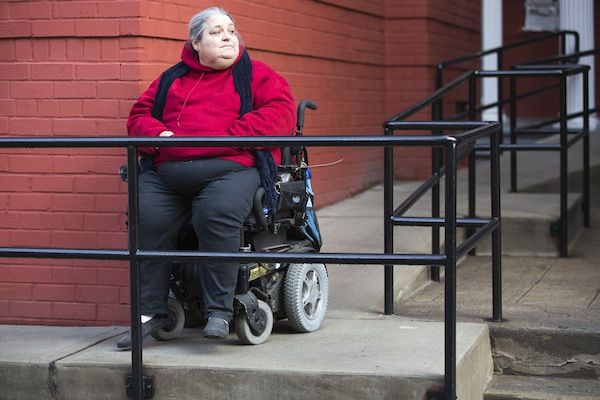At Gov. David Paterson’s April 16, 2009 press conference announcing the introduction of same-sex marriage legislation, Mayor Michael Bloomberg was about to speak when music started playing in the back of the press gaggle. A photographer had bumped into reporter Michael Harris, turning on his audio recorder. Being a wheelchair user, Harris was unable to reach the machine to turn it off. Rather than continuing over the distraction — which was playing softly enough that many in the room could not hear it — or urging someone nearby to help him, Bloomberg got angry. He stopped, glared dramatically at Harris, and demanded, “Can we just stop this, and maybe we’ll start again?” City Council Speaker Christine Quinn, leaned over to the mayor, and whispered, “He’s disabled.” “I understand that — he can still turn it off,” replied Bloomberg. As the New York Times reported, “It was almost a full 60 seconds — punctuated by sighing and glowering from Mr. Bloomberg and more than a few quizzical looks from members of the audience — before Mr. Harris shut the machine off.”
That incident placed on full display an attitude towards the disabled — insensitive and imperious — that advocates for disabled New Yorkers say their constituency has suffered throughout Bloomberg’s tenure. In looking at Bloomberg’s record on disability issues, a regular theme emerges: that he has simply not prioritized expanding opportunities for people with disabilities. Whenever a competing priority emerges, people with disabilities feel they lose out.
“The city’s position [on disability issues] is very defensive,” says Marvin Wasserman, former executive director of the Brooklyn Center for Independence of the Disabled (BCID). “It’s, ‘We’re doing the best we can. We’re not violating the law; we’re the experts. Screw you.’”
The disabled are disproportionately poor and unemployed. “In New York City, there is a tremendous employment gap between people with and without disabilities, and earnings lag behind for people with disabilities,” says Susan Dooha, executive director of the Center for Independence of the Disabled in New York (CIDNY).
According to data from the Disability Statistics Center at Cornell, drawn from the 2011 American Community Survey, the estimated employment rate of the 425,781 people with disabilities in New York City ages 18-64 in 2011 was 28.4 percent. For New Yorkers without disabilities, it was 69.2 percent.
This dramatic disparity can also be found at the state and national level. But failure to address the inequality is the central disappointment of Bloomberg’s mayoralty for the disability community, and some advocates speculate that the economic limitations of the disabled partially explain Bloomberg’s attitude towards them.
“The man doesn’t have a lot of experience with people with disabilities,” says Edith Prentiss, vice-president for legislative affairs at Disabled in Action of Metro New York. “It’s not part of his milieu; it’s not part of his cohort. People with disabilities don’t jet off to Bermuda.”
Taxi Battle Angers Advocates
In order to hold a job you must be able to get to it. One of the reasons disabled unemployment is so high is that the city’s transportation infrastructure remains largely impossible to navigate for people with mobility limitations. This is not entirely within the mayor’s control: Most subway stations are not wheelchair-accessible, but responsibility for that lies with the MTA, not City Hall. However, advocates say Bloomberg has not made improving city-controlled alternatives a priority.
Bloomberg passed on the opportunity to make taxis, a major component of New York’s transportation system, wheelchair accessible. City Hall heavily promoted the virtues of the “Taxi of Tomorrow.” But when selecting a design, Bloomberg refused entreaties from the disability community — and the city comptroller and public advocate, among others — to choose a wheelchair-accessible design. “Bloomberg was obstinate and adamant about not making accessible taxis,” says James Weissman, senior vice-president and general counsel for the United Spinal Association.
The Taxi and Limousine Commission (TLC) thinks that their solution is the ideal compromise: 2,000 holders of new taxi medallions will have accessible cars, in addition to the 233 already in circulation. “It’s not an efficient way to go about it, making them all accessible,” says Alan Fromberg, a spokesman for the TLC. “It’s extremely costly. It costs an additional $15,000 to modify [the Taxi of Tomorrow] to wheelchair accessibility.”
Fromberg argues that the oft-cited analogy to London, where the entire taxi fleet is accessible, is inappropriate. “The London cab is not accessible to the U.S. standard,” he says. “The U.S. standard is more stringent. The ramp in London is much more steep, which is not legal in the United States.”
But disability advocates find Bloomberg’s explanations unconvincing. Bloomberg claimed that taxi drivers are opposed to accessible cabs because riders in them sit farther away from the driver, thus preventing the driver from establishing a rapport with the passenger to earn a bigger tip. As anyone who uses New York taxis knows, for the vast majority of rides, cabbies talk on their phones or listen to the radio. Even if Bloomberg’s theory were true, advocates say, it’s an offensively weak reason to deny disabled New Yorkers equal access to a vital mode of transportation. “Every time Bloomberg speaks on taxis, people with disabilities got more outraged,” says Wasserman.
Bloomberg also maintains that accessible cabs are less comfortable for non-disabled passengers. Disability advocates suspect the real issue is that cab drivers don’t want to pick up passengers with disabilities because they may take longer to enter and exit.
The federal government has filed suit against the city to require more accessible taxis in the fleet. “The taxi thing was insulting to people with disabilities,” says Weissman. “The governor supported [accessible taxis], the state legislature supported it, and Bloomberg opposed it and won.”
The TLC promises that their full slate of proposed reforms, such as the street hail system for livery car services, will improve accessibility. “While the legal challenge on the issue of whether street hails would infringe on the business of yellow cabs, and the budgetary aspect of selling an additional 2,000 wheelchair accessible medallions tend to get more attention, the fact that a full 20 percent of the [outer]-borough taxis must be accessible and available via hail and phone arrangement is an important and needed component to our efforts to advance accessibility,” writes Fromberg in an email.
But people with disabilities complain that current requirements are often unenforced. For example, car services are required to offer wheelchair-accessible automobiles. In practice, Prentiss says she often finds that they send cars that cannot accommodate a non-folding wheelchair such as hers. Fromberg says TLC “regularly enforce[s] violations when they are brought to our attention.”
There are myriad other impediments to traversing the city in a wheelchair or on crutches that Bloomberg has failed to address. Some disability advocates say that the city fails to enforce transportation laws that protect the disabled. In particular, the uptick in bicycling poses a risk, according to Prentiss. “When people have to attempt to cross a street and they are in the safe refuge it can be frightening when the bicycles swoop down,” she says. “And the bicycles are not following the regulations. The other day a bike came kicking ass in the wrong direction, jumping out at me in the dark with no light on. The bottom line is they’re not enforcing the law.”
While many pedestrians have complaints about their interactions with bikers (and drivers), the disabled are in a tougher position simply because it’s harder for them to jump out of the way.
The city’s Department of Transportation responds by noting that traffic fatalities are down in recent years. “The last five years recorded the fewest traffic fatalities in a century of record- keeping and… overall traffic fatalities have plunged by about 38 percent over the last decade,” writes Nicholas Mosquera of DOT in an email. Mosquera also points out that DOT is expanding various efforts to improve pedestrian safety, such as tactile strips to make it easier to identify curb cuts and pedestrian countdown signals to more than 1,900 intersections.
Tensions After Irene and Sandy Revealed
People with disabilities don’t just have to worry about transportation, but whether their destination is navigable once they have arrived. Essential public facilities often remain inaccessible. New York’s recent experiences with hurricanes, for example, exposed shortcomings in accessibility for emergency shelters.
“In the wake of Irene we sued the city for lack of emergency preparedness for people with disabilities, going all the way back to 9/11 but highlighted by the experience with Irene,” recalls Wasserman. “They had evacuation on an inaccessible [to the visually impaired] Web site. Emergency shelters all had floors retarding access and inaccessible entrances and bathrooms. Volunteers didn’t have the necessary keys for accessible entrances. There were inaccessible cots.”
These sorts of problems with transportation, housing and emergency management for people with disabilities continued with Hurricane Sandy. “Despite Mayor Bloomberg’s statement at the time of the mandatory evacuation order that shelters were accessible, many were not in fact accessible,” writes Joan Peters, executive director of BCID, in an email to City Limits. “However, the lack of accessibility in the shelters is just one aspect of the larger failure of New York City to adequately plan for people with disabilities during an emergency.”
“In addition, many people with disabilities outside of evacuation zones were severely impacted [by] the city’s failure to plan,” adds Peters. “There is no evacuation plan to rescue people with disabilities from high-rises. Nor is there a plan for extended power outages. In Sandy, power was cut off with little notice, leaving hundreds, perhaps thousands of people who could not climb steps or navigate steps trapped in their apartments, without access to food, water or supplies, or without a way to power ventilators, nebulizers and other medically necessary devices.”
In a statement, Victor Calise, commissioner of the Mayor’s Office for People with Disabilities, said: “The Mayor’s Office for People with Disabilities worked directly with disability rights activists and our agency partners before, during and after the hurricane in order to quickly and efficiently assist people with disabilities with all of their needs, including helping to obtain critical resources and providing timely information regarding all facets (i.e. transportation and power outage updates; shelter, evacuation center and Restoration Center locations; food and dry-ice drop-offs, etc.) of the aftermath of the storm. We continue to participate in tri-weekly calls between FEMA and the disabled community to help understand and problem-solve immediate issues and concerns.”
City Hall didn’t respond to questions about other aspects of the mayor’s performance on disability issues.
Trouble at School
Accessibility issues don’t just confront the disabled during emergencies; they can crop up on any school day.
The city publishes a list of schools, of which there are about 750 citywide, that are accessible to students with physical disabilities. But some of those schools are only accessible on the first floor, or are only partially accessible, meaning that some relevant facilities, such as the auditorium, are not. The list is also as notable for what is not on as what is. There are over 1,700 public schools in New York City. The most elite public high schools, such as Stuyvesant and Bronx Science, are accessible. But some high schools with sought-after magnet programs, such as Midwood in Brooklyn and the High School for Math, Science and Engineering at City College, are not.
This is particularly problematic in light of Bloomberg’s commitment to school choice. One’s nearest school may be inaccessible, forcing disabled students to travel far away for no particular educational advantage. Many of the schools featuring special citywide programs, including many high schools, are simply unavailable to students with disabilities. “Physical accessibility to school buildings is way limited and therefore access to model programs that other students have is also limited,” says Maggie Moroff, special education policy coordinator at Advocates for Children (AFC). “Most of the high schools I’ve visited are inaccessible. It’s not based on whether it’s a good program or bad program or sought-after program. If you can’t get into the building, you can’t get into the program.”
Disabled students seem to also suffer poor academic outcomes. Statistics are only available for all special education students, which include students with learning and cognitive disabilities as well as physical ones, but the numbers are troubling. For the class of 2011, only 27.2 percent of students with disabilities graduated from high school by June of their fourth year. (This was an improvement over the 17.1 percent June graduation rate for students with disabilities in 2005, but still far below the 2011 graduation rate for non-disabled students of 66.9 percent.) One reason for this disparity may be material that is inaccessible to children with disabilities such as visual impairments. “We fight over and over again the battle for individual families to make the material accessible, to digitalize it, for example,” says Moroff. “But why not generalize it so they don’t have to reinvent the wheel every time?”
In some cases, disabled students are not getting the services to which they are clearly entitled. A 2011 report from the ARISE Coalition, a New York public school advocacy group, studied 222 Individualized Education Programs, and found that schools were often ignoring their obligation to identify “transition services,” that will help disabled high-school students continue their education, obtain vocational training or employment and access services for their health and independent living. This was consistent with what DOE itself determined in a review of a random sample of their student IEPs from the 2005-2006 academic year, reporting, “None of their IEPs met all of the compliance indicators.”
The DOE points to a set of special education reforms, launched in 2011. The emphasis is on mainstreaming students with disabilities. The graduation rate is an abysmal 5 percent for disabled students who are fully segregated into special education classes. Forty percent of disabled students spend some or all of their day in separate classes.
Workforce Policies in Question
Educating disabled children and preparing them to join the workforce is not the only way that the city can affect disabled employment. Advocates say the city and state have failed the disabled in other realms as well.
If nothing else, city government can employ people with disabilities who face discrimination elsewhere. New York City has a program, called 55-A after its section of the Civil Service Act, permitting the disabled to obtain civil service status without having to take the standard exams. In recent years, as the economic downturn has led to austerity measures, disability advocates contend that workers hired through that program have been disproportionately likely to suffer layoffs.
In May 2011, 37 disabled employees of the Department of Finance sued the city, alleging that they were being laid off in a discriminatory manner. Of DOF’s 2,300 employees, 129 employees were targeted for layoffs, including 78 who held the entry-level job title of Office Machine Aide (OMA), the large majority of whom were disabled and hired through the 55-A program. District Council 37 also complained that the layoffs were taking place despite DOF having hired many much more highly paid managers in the previous year. The complaint was initially dismissed by the district judge. But that decision was appealed and unanimously overruled in August 2012 by the appellate court.
Disability advocates say that the city has also been unhelpful to people with disabilities looking for work. The federal Workforce Investment Act of 1998 created “One-Stop” centers to streamline the various training and placement programs available to the unemployed. But studies found that One-Stop centers were assisting a disproportionately low number of people with disabilities because they presented information in a non-accessible manner and directed the disabled to the Vocational Rehabilitation agency instead of just helping them find a job. Consequently, a program was developed to place disability resource coordinators (DRC) at One-Stop centers to ensure that people with disabilities could use the resources. But New York City chose not to participate in New York State’s DRC program.
More Than a Mayor
It is not as if Mayor Bloomberg is uniquely insensitive to the needs of the disabled. Disabled New Yorkers face inaccessible buildings and subpar services from plenty of entities not under mayoral control. The MTA, for example, has failed to update its subway infrastructure to make the system accessible.
Even the system that will be used to select Bloomberg’s successor poses problems for the disabled. The Board of Elections has been especially slow to adjust to the requirements of the ADA. In August 2012 a federal judge ruled that the New York City Board of Elections fails to provide access to polling places for voters who use wheelchairs or scooters or have vision impairments. Some polling places are in non-wheelchair accessible buildings, while others that are architecturally accessible had locked doors to wheelchair accessible entrances or objects like garbage cans blocking the wheelchair ramp and inadequate signage for the visually impaired.
“The city has been terrible about making polling places accessible and making sure that disabled people can exercise the franchise,” says Weissman.
The problem, in other words, is broader than one government or administration. (Disability advocates say Bloomberg’s predecessor, Rudy Giuliani, was no friend of their community either.) Token gestures meant to demonstrate awareness or sensitivity do not help, they say, although they do credit Bloomberg with creating the role of commissioner of the Mayor’s Office for People with Disabilities. The current commissioner, Calise, is well-regarded by the disability advocacy community, as was his predecessor, the late Matthew Sapolin. But, they say, the commissioner has a small office with little actual power.
“I consider [Bloomberg] to be a civil libertarian who is pro-rights, pro-gay marriage,” says Weissman. “It’s ludicrous that someone could be pro-gay marriage but want less for people with disabilities than for everyone else.”

Ben Adler is a journalist in New York. He is a former reporter for Grist, The Nation, Newsweek and Politico, and he has written for The New York Times, The Atlantic, The Guardian and The New Republic.
















